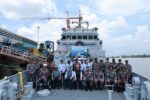Astroscale U.S. has entered into a pivotal agreement with NASA to conduct on-orbit testing of Rendezvous and Proximity Operations (RPO), a cornerstone capability for future satellite servicing, debris mitigation, and orbital logistics. The collaboration will leverage Astroscale’s advanced spacecraft platform and NASA’s extensive experience in space operations to validate technologies critical for sustainable use of low Earth orbit (LEO).
Strategic Importance of RPO in Modern Space Operations
Rendezvous and Proximity Operations (RPO) refer to the controlled approach of one spacecraft toward another in orbit—a foundational capability for a range of emerging mission types including satellite refueling, life extension services, debris removal, inspection missions, and assembly of large structures in space.
As the number of satellites proliferates—particularly in LEO where mega-constellations are driving congestion—RPO is becoming essential not only for commercial servicing but also for national security missions such as threat characterization or rapid response repairs. RPO also underpins future cislunar operations where autonomous docking will be vital.
Details of the Astroscale-NASA Partnership
The agreement between Astroscale U.S. Inc. and NASA’s Goddard Space Flight Center was formalized under a no-exchange-of-funds Reimbursable Space Act Agreement (RSAA). The project will focus on demonstrating safe RPO maneuvers using Astroscale’s Life Extension In-Orbit (LEXI) spacecraft platform—a modular vehicle designed for geostationary satellite servicing but adaptable for LEO applications.
NASA will provide technical consultation on navigation algorithms, safety protocols for proximity operations near active or defunct satellites, and mission design best practices based on decades of human spaceflight experience. In return, Astroscale will share telemetry data from its upcoming test missions that could inform future standards development for autonomous RPO systems.
LEXI Platform Capabilities and Mission Profile
The LEXI spacecraft is part of Astroscale’s broader portfolio aimed at enabling long-term orbital sustainability through active debris removal (ADR), end-of-life services (EOL), inspection capabilities, and life extension modules. While originally tailored for GEO clients requiring station-keeping support or propulsion augmentation, the platform’s modularity allows it to be adapted for LEO-based testing scenarios.
Key features include:
- Autonomous rendezvous navigation suite using optical sensors and GNSS
- Robust fault management system with safe-mode triggers during close approach
- A standardized docking interface compatible with multiple client satellite designs
- Secure command-and-control architecture hardened against cyber threats
The upcoming demonstration mission is expected to involve simulated rendezvous with a non-cooperative target object—likely an inert upper stage or retired smallsat—to validate relative navigation systems under realistic conditions.
Implications for National Security and Commercial Servicing Markets
The ability to perform safe RPO has growing implications beyond commercial markets. For defense agencies such as the U.S. Space Force or NRO (National Reconnaissance Office), having access to trusted domestic providers capable of inspecting or maneuvering near foreign assets is increasingly critical amid rising counterspace threats from adversaries like China or Russia.
This partnership positions Astroscale as a key dual-use technology provider whose platforms could support both civil SSA (space situational awareness) efforts and classified ISR tasks involving close-up inspection or anomaly resolution on high-value satellites.
Commercially, the demand curve is steepening as operators seek ways to extend asset lifespans without costly replacements—especially given supply chain constraints affecting new satellite production timelines post-2023.
Toward Norms Development and Regulatory Frameworks
A major objective of this collaboration is to contribute empirical data toward shaping international norms around responsible behavior during proximity operations. Currently there are limited binding agreements governing how close one spacecraft can approach another without prior coordination—a gap that raises risks of miscalculation or escalation in contested orbital regimes.
NATO allies have increasingly called for transparency measures around RPO activities following incidents involving Russian “inspector” satellites shadowing Western assets in GEO belt since 2017. By demonstrating best practices through joint civil-commercial missions like this one, stakeholders hope to build momentum toward multilateral codes of conduct that balance operational freedom with safety assurances.
Next Steps: Timeline and Future Missions
The first integrated test flight involving LEXI under this agreement is expected no earlier than 2026 depending on launch manifest availability. Meanwhile Astroscale continues separate work under its OSAM-1 contract with DARPA focused on robotic arm-based servicing technologies—a complementary pathway that could eventually converge with autonomous RPO capabilities validated via this NASA partnership.
If successful, follow-on missions may include cooperative docking trials with willing commercial partners or even limited repair tasks using modular toolkits deployed from the LEXI bus—laying groundwork for an eventual ecosystem of orbital service providers operating across altitudes from LEO through GEO.
Conclusion: Building Blocks Toward Orbital Sustainment Infrastructure
This partnership between Astroscale U.S. and NASA represents more than just a technical milestone—it signals growing convergence between public sector stewardship goals and private sector innovation capacity in building out the infrastructure needed for sustainable orbital presence over coming decades.
The success of such initiatives will determine not only commercial ROI but also strategic resilience across military space architectures increasingly reliant on persistent ISR constellations vulnerable to degradation without rapid-response maintenance options enabled by mature RPO capabilities.









